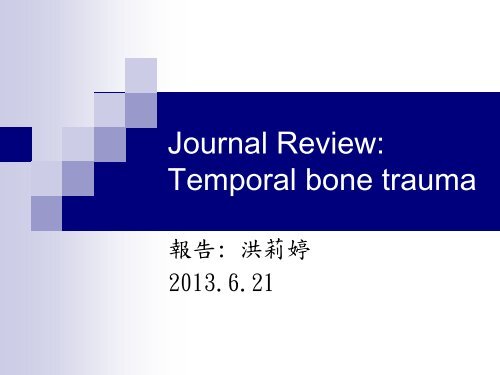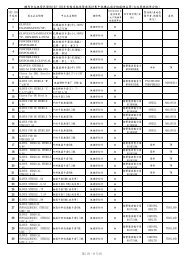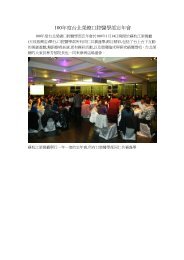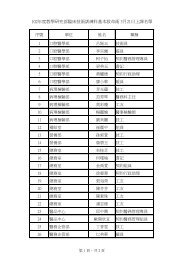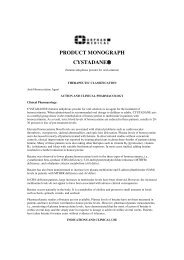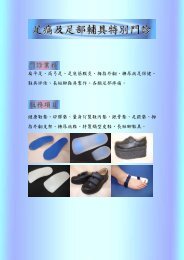Management of Temporal Bone Trauma Craniomaxillofacial trauma ...
Management of Temporal Bone Trauma Craniomaxillofacial trauma ...
Management of Temporal Bone Trauma Craniomaxillofacial trauma ...
Create successful ePaper yourself
Turn your PDF publications into a flip-book with our unique Google optimized e-Paper software.
Journal Review:<br />
<strong>Temporal</strong> bone <strong>trauma</strong><br />
報告: 洪莉婷<br />
2013.6.21
Introduction<br />
Injuries to the temporal bone occur in 30-<br />
70% <strong>of</strong> cases involving blunt head <strong>trauma</strong>.<br />
Commonly suffer from multiple other body<br />
injuries.<br />
Motor vehicle accidents are the most<br />
common cause, with falls and gunshot<br />
wounds contributing to a lesser extent.<br />
CRANIOMAXILLOFACIAL TRAUMA & RECONSTRUCTION/VOLUME 3, NUMBER 2 2010
Complications<br />
Intracranial hemorrhage, cerebral<br />
contusion, meningitis, hearing loss, facial<br />
paralysis, cerebrospinal fluid fistula,<br />
cholesteatoma and external auditory canal<br />
stenosis.<br />
May result in death or permanent deficits.<br />
CRANIOMAXILLOFACIAL TRAUMA & RECONSTRUCTION/VOLUME 3, NUMBER 2 2010
Anatomy and function<br />
The temporal bones form parts <strong>of</strong> the middle<br />
and posterior cranial fossa and contribute to the<br />
neurocranium or skull base.<br />
Protecting the brain, middle and internal ear<br />
apparatus including the cochlea, vestibule and<br />
the vestibulocochlear nerve (cranial nerve VIII),<br />
the facial nerve (cranial nerve VII), the internal<br />
carotid artery, and the jugular vein.<br />
CRANIOMAXILLOFACIAL TRAUMA & RECONSTRUCTION/VOLUME 3, NUMBER 2 2010
Anatomy<br />
Each temporal bone is divided into five<br />
components: squamous, tympanic, styloid,<br />
mastoid, and petrous.<br />
CRANIOMAXILLOFACIAL TRAUMA & RECONSTRUCTION/VOLUME 3, NUMBER 2 2010
Styloid process
Symptom<br />
Hearing loss: immediately apparent to conscious<br />
patients, the most common (40% <strong>of</strong> patients with<br />
head injury).<br />
± tinnitus: no prognostic significance<br />
Dizziness and dysequilibrium <strong>of</strong>ten noticed<br />
unless severe labyrinthine injury has occurred.<br />
Many patients notice imbalance only after becoming<br />
ambulatory.<br />
CRANIOMAXILLOFACIAL TRAUMA & RECONSTRUCTION/VOLUME 3, NUMBER 2 2010
PHYSICAL EXAMINATION<br />
Nystagmus: vestibular injury, the direction<br />
<strong>of</strong> nystagmus is usually away from the<br />
affected ear.<br />
Extensive physical assessment <strong>of</strong><br />
vestibular complaints immediately after<br />
temporal bone <strong>trauma</strong> is unnecessary, as<br />
complete recovery from imbalance and<br />
nystagmus is to be expected.<br />
CRANIOMAXILLOFACIAL TRAUMA & RECONSTRUCTION/VOLUME 3, NUMBER 2 2010
Sign<br />
Hemotympanum<br />
With history <strong>of</strong> head <strong>trauma</strong> are sufficient for<br />
the diagnosis <strong>of</strong> temporal bone fracture, even<br />
in the absence <strong>of</strong> radiographic evidence.<br />
Postauricular ecchymosis or Battle’s sign: fracture<br />
defect usually involves the mastoid cortex or<br />
squamous portion.<br />
Periorbital ecchymosis or raccoon sign<br />
CRANIOMAXILLOFACIAL TRAUMA & RECONSTRUCTION/VOLUME 3, NUMBER 2 2010
PHYSICAL EXAMINATION<br />
Facial paresis (weakness)<br />
Easily unnoticed due to facial swelling, lacerations,<br />
and abrasions.<br />
Immediate: the first few hours after injury<br />
Hilger nerve stimulator, day 3~7 after injury.<br />
No loss <strong>of</strong> stimulability→ observed.<br />
Loses stimulability → facial nerve exploration<br />
Late-onset: delayed for days or weeks, common.<br />
2-week systemic corticosteroids and observed<br />
Generally has an excellent recovery <strong>of</strong> function.<br />
Cummings Otolaryngology: Head & Neck Surgery, 5th ed. Chap.145<br />
CRANIOMAXILLOFACIAL TRAUMA & RECONSTRUCTION/VOLUME 3, NUMBER 2 2010
http://www.audiologyonline.com/articles/electroneuronography-enog-neurophysiologic-evaluation-facial-1225
PHYSICAL EXAMINATION<br />
CN V injury: facial hypesthesia (decreased or<br />
absent touch sensation)<br />
CN VI injury: diplopia<br />
Uncommon<br />
Usually not noticed immediately after injury<br />
→ Edema is responsible for the damage (not<br />
direct <strong>trauma</strong>)<br />
Spontaneous recovery <strong>of</strong> both facial hypesthesia<br />
and diplopia is the general rule.<br />
CRANIOMAXILLOFACIAL TRAUMA & RECONSTRUCTION/VOLUME 3, NUMBER 2 2010
RADIOGRAPHIC EVALUATION<br />
High-resolution CT scans with bone algorithms<br />
are the standard.<br />
>1/3 fractures detected by CT are missed by clinical<br />
diagnosis.<br />
Invaluable in assessing the location <strong>of</strong> facial nerve<br />
injury, as well as for planning surgical approaches.<br />
MRI: useful in corroborating cranial nerve injury.<br />
Gunshot wounds or other penetrating <strong>trauma</strong>→<br />
angiography or MRA: greater possibility <strong>of</strong> injury<br />
to the internal carotid artery.<br />
CRANIOMAXILLOFACIAL TRAUMA & RECONSTRUCTION/VOLUME 3, NUMBER 2 2010
Traditional Classification<br />
Emerg Radiol (2009) 16:255–265
Hearing loss Injury site Fracture type<br />
Conductive conducting<br />
repaired at any time<br />
system distal<br />
to the<br />
cochlea<br />
Mixed Both<br />
Sensorineural Internal ear (<br />
Poor prognosis,<br />
not influenced by<br />
treatment<br />
cochlea and<br />
CN VIII)<br />
Longitudinal fractures <strong>of</strong><br />
the temporal bone or<br />
injuries with no<br />
identfiable fracture<br />
Transverse fracture<br />
Hearing loss type: Prognostically important but does<br />
not influence the timing <strong>of</strong> surgery.<br />
CRANIOMAXILLOFACIAL TRAUMA & RECONSTRUCTION/VOLUME 3, NUMBER 2 2010
Otic capsule-based classification<br />
Otic capsule: the bone that<br />
houses the cochlea and the<br />
semicircular canals.<br />
More clinically relevant.<br />
Cummings Otolaryngology: Head & Neck Surgery, 5th ed. Chap.145<br />
Clinical Otolaryngology, 31, 287–291
Otic sparing fracture Otic capsule–disrupting<br />
Incidence 94.2-97.5% 2.5-5.8%<br />
Cause blow to temporo- parietal<br />
region.<br />
Pathway Mastoid air cell, middle ear→<br />
tegmen mastoideum →<br />
tegmen tympani → tegmen in<br />
the region <strong>of</strong> the facial hiatus<br />
Involvement Squamosal portion <strong>of</strong><br />
temporal bone, posterosuperior<br />
wall <strong>of</strong> EAC<br />
blows to the occipital<br />
region<br />
Foramen magnum →<br />
petrous pyramid and otic<br />
capsule→ jugular<br />
foramen, IAC, foramen<br />
lacerum<br />
Not typically affect the<br />
ossicular chain or EAC<br />
Hearing loss Conductive/mixed HL SNHL (7 times)<br />
Facial nerve<br />
paralysis<br />
6-14% 30-50%<br />
CSF fistula 1X 2-4X<br />
Cummings Otolaryngology: Head & Neck Surgery, 5th ed. Chap.145<br />
Clinical Otolaryngology, 31, 287–291<br />
More epidural hematoma,<br />
SAH
Evaluation<br />
Electroneuronography (ENOG): the most<br />
effective method for testing facial nerve function,<br />
by comparing the summated action potential <strong>of</strong><br />
the affected side with that <strong>of</strong> the uninjured side.<br />
Any observation <strong>of</strong> facial paralysis should be<br />
followed with ENOG.<br />
ENOG is generally performed 2 to 3 days after<br />
facial nerve injury but within 2 to 3 weeks.<br />
CRANIOMAXILLOFACIAL TRAUMA & RECONSTRUCTION/VOLUME 3, NUMBER 2 2010
Emergent intervention<br />
Obvious brain herniation (encephalocele)<br />
into the middle ear, mastoid, or external<br />
acoustic meatus.<br />
Massive bleeding from intratemporal<br />
carotid artery laceration.<br />
Balloon occlusion <strong>of</strong> the vessel is generally<br />
faster than surgical ligation and repair.<br />
CRANIOMAXILLOFACIAL TRAUMA & RECONSTRUCTION/VOLUME 3, NUMBER 2 2010
Early surgical intervention for facial<br />
nerve paresis<br />
Immediate paralysis and no evidence <strong>of</strong><br />
return <strong>of</strong> function after 1 week.<br />
Immediate paralysis + significant temporal<br />
bone disruption (CT): severe nerve<br />
laceration or sectioning.<br />
Immediate paralysis and progressive<br />
decline in ENOG functioning to less than<br />
10% <strong>of</strong> the normal side.<br />
CRANIOMAXILLOFACIAL TRAUMA & RECONSTRUCTION/VOLUME 3, NUMBER 2 2010
Transmastoid approach<br />
Only for lesions determined to be distal to the<br />
geniculate ganglion.<br />
Postauricular ecchymosis (Battle’s sign): the fracture defect usually<br />
involves the mastoid cortex or squamous portion. The fracture line<br />
can be followed medially to the point <strong>of</strong> facial nerve injury.<br />
CRANIOMAXILLOFACIAL TRAUMA & RECONSTRUCTION/VOLUME 3, NUMBER 2 2010
Middle cranial fossa approach<br />
Geniculate<br />
ganglion<br />
Facial nerve injury proximal to the geniculate<br />
ganglion and no sensorineural hearing deficits.<br />
CRANIOMAXILLOFACIAL TRAUMA & RECONSTRUCTION/VOLUME 3, NUMBER 2 2010
Transmastoid-translabyrinthine<br />
approach<br />
For sensorineural hearing loss that is unlikely to improve.<br />
Less associated morbidity than the middle cranial fossa<br />
approach<br />
CRANIOMAXILLOFACIAL TRAUMA & RECONSTRUCTION/VOLUME 3, NUMBER 2 2010
Facial nerve decompression<br />
Identify location <strong>of</strong> facial nerve injury, removed<br />
any bone chips.<br />
Examined for stretching, compression,<br />
laceration, or transection.<br />
Largely intact nerve→ decompression <strong>of</strong> the<br />
epineural sheath in proximal to distal.<br />
Partial transection→ repaired with suture.<br />
Separation >50% <strong>of</strong> the axons→ interpositional<br />
nerve graft (greater auricular nerve)<br />
CRANIOMAXILLOFACIAL TRAUMA & RECONSTRUCTION/VOLUME 3, NUMBER 2 2010
<strong>Management</strong><br />
<strong>of</strong> <strong>trauma</strong>tic<br />
facial<br />
paralysis.<br />
Cummings Otolaryngology: Head & Neck Surgery,<br />
5th ed. Chap.145
CSF leakage<br />
Usually resolves spontaneously within 2 weeks without<br />
intervention.<br />
Antibiotics are not routinely prescribed, for fear <strong>of</strong><br />
masking early infection.<br />
No statistically significant effect on the incidence <strong>of</strong><br />
meningitis .<br />
Questioned frequently about meningeal symptoms<br />
(headaches with nuchal rigidity, photophobia)<br />
Lumbar puncture if meningitis is suspected, before<br />
beginning antibiotic therapy.<br />
CRANIOMAXILLOFACIAL TRAUMA & RECONSTRUCTION/VOLUME 3, NUMBER 2 2010
CSF leakage- surgical intervention<br />
Surgery is indicated for continuous CSF otorrhea<br />
or rhinorrhea persisting longer than 14 days.<br />
If lumbar drainage for 72 hours fails, surgical<br />
exploration is recommended for closure <strong>of</strong> the<br />
dural tear and prevention <strong>of</strong> meningitis.<br />
Dehiscent brain tissue extending into the<br />
temporal bone is nonfunctional and can be<br />
removed by electrocautery.<br />
CRANIOMAXILLOFACIAL TRAUMA & RECONSTRUCTION/VOLUME 3, NUMBER 2 2010
Cummings<br />
Otolaryngology: Head &<br />
Neck Surgery,<br />
5th ed. Chap.145
<strong>Management</strong>- hearing<br />
Conductive hearing loss secondary to<br />
hemotympanum resolves without intervention.<br />
Ossicular disruption can be repaired electively.<br />
Surgery is not recommended earlier than 3<br />
months after <strong>trauma</strong> because <strong>of</strong> postinjury<br />
edema, bleeding, and friability <strong>of</strong> healing tissues.<br />
Sensorineural hearing loss may show<br />
improvement over time but tends to persist and<br />
is refractory to treatment.<br />
CRANIOMAXILLOFACIAL TRAUMA & RECONSTRUCTION/VOLUME 3, NUMBER 2 2010
<strong>Management</strong><br />
Intravenous corticosteroids: reduce edema<br />
in and around the nerve, for sensorineural<br />
hearing loss and facial nerve injury.<br />
Little data examining the efficacy<br />
Relatively inexpensive, and a short course <strong>of</strong><br />
steroids presents minimal risk <strong>of</strong><br />
complications.<br />
CRANIOMAXILLOFACIAL TRAUMA & RECONSTRUCTION/VOLUME 3, NUMBER 2 2010
<strong>Management</strong><br />
Dysequilibrium usually responds to activity and<br />
should resolve without additional intervention.<br />
Benign paroxysmal positional vertigo can follow<br />
head injury after days to weeks, resolves<br />
spontaneously.<br />
Vestibular suppressants: used briefly, tapered<br />
rapidly to allow for CNS compensation.<br />
Early ambulation also stimulates CNS<br />
compensation.<br />
CRANIOMAXILLOFACIAL TRAUMA & RECONSTRUCTION/VOLUME 3, NUMBER 2 2010
Reference<br />
<strong>Management</strong> <strong>of</strong> <strong>Temporal</strong> <strong>Bone</strong> <strong>Trauma</strong><br />
Craniomaxill<strong>of</strong>acial <strong>trauma</strong> & reconstruction/volume 3,<br />
number 2, 2010<br />
<strong>Temporal</strong> bone fractures<br />
Emerg Radiol (2009) 16:255–265<br />
<strong>Management</strong> <strong>of</strong> <strong>Temporal</strong> <strong>Bone</strong> <strong>Trauma</strong><br />
Cummings Otolaryngology: Head & Neck Surgery, 5th<br />
ed. Chap. 145<br />
A comparison <strong>of</strong> temporal bone fracture<br />
classification systems<br />
Clinical Otolaryngology, 31, 287–291
Thanks for your attention !


